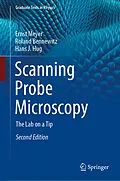Written by three leading experts in the field, this book describes and explains all essential aspects of scanning probe microscopy. Emphasis is placed on the experimental design and procedures required to optimize the performance of the various methods described. The book covers not only the physical principles behind this popular technique, but also tackles questions on instrument design, the basic features of the different imaging modes, and recurring artifacts. Novel applications and the latest research results are presented, and the book closes with a look at the future prospects of scanning probe microscopy, while also discussing related techniques in the field of nanoscience.
This second edition includes essential scientific updates reflecting the latest research, as well as coverage of new breakthroughs in techniques such as submolecular imaging by atomic force microscopy (AFM), multifrequency AFM, high-speed imaging of biological matter, scanning x-ray microscopy, and tip-enhanced Raman scattering.
The book serves as a general, hands-on guide for all types of classes that address scanning probe microscopy. It is ideally suited for graduate and advanced undergraduate students, either for self-study or as a textbook for a dedicated course on the topic. Furthermore, it is an essential component of any scanning probe microscopy laboratory course and a valuable resource for practicing researchers developing and using scanning probe techniques.Autorentext
Ernst Meyer is Professor of Physics at the University of Basel and an expert in the field of atomic force microscopy. He has chaired European programmes for the study of nanotribology and is member of the executive board of the Swiss Nanoscience Institute. His research focuses on scientific questions in the fields of nanomechanics and nanoelectronics.
Roland Bennewitz is Professor of Physics at Saarland University and group leader at the Leibniz Institute for New Materials (INM) in Saarbrücken, Germany. His main areas of expertise are high-resolution friction force microscopy, force microscopy of liquid-solid interfaces, and control of adhesion and friction by macromolecular functionalization or ionic liquids. He has chaired international conferences such are the Gordon Research Conference in Tribology 2014 and a Beilstein Symposium on Molecular Mechanisms in Tribology in 2016. He currently serves as on the Editorial Board of the Journal Tribology Letters.
Hans Josef Hug is Professor of Physics at the University of Basel and laboratory head at the Empa - Swiss Federal Laboratories for Materials Testing and Research in Dübendorf, near Zürich, where he leads the laboratory for Magnetic and Functional Thin Films. In 2003 he and his team received the Swiss Technology Award for the development of high resolution and quantitative magnetic force microscopy. His main areas of expertise are magnetism and magnetic thin film systems and scanning force microscopy with a particular emphasis on magnetic force microscopy.
Klappentext
Written by three leading experts in the field, this textbook describes and explains all aspects of the scanning probe microscopy. Emphasis is placed on the experimental design and procedures required to optimize the performance of the various methods. Scanning Probe Microscopy covers not only the physical principles behind scanning probe microscopy but also questions of instrumental designs, basic features of the different imaging modes, and recurring artifacts. The intention is to provide a general textbook for all types of classes that address scanning probe microscopy. Third year undergraduates and beyond should be able to use it for self-study or as textbook to accompany a course on probe microscopy. Furthermore, it will be valuable as reference book in any scanning probe microscopy laboratory. Novel applications and the latest important results are also presented, and the book closes with a look at the future prospects of scanning probe microscopy, also discussing related techniques in nanoscience. Ideally suited as an introduction for graduate students, the book will also serve as a valuable reference for practising researchers developing and using scanning probe techniques.
